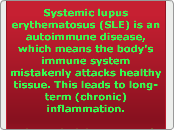Systemic Lupus Erythematosus
Systemic lupus erythematosus (SLE) is an autoimmune disease, which means the body's immune system mistakenly attacks healthy tissue. This leads to long-term (chronic) inflammation.
The underlying cause of autoimmune diseases is not fully known.
Risks:
Women- especially those within child bearing age
African Americans
Genetic predisposition
Sun exposure and sunburns- UVA/UVB
Type III hypersensitivity response
Signs/Symptoms:
Almost everyone with SLE has joint pain and swelling
Some develop arthritis. Frequently affected joints are the fingers, hands, wrists, and knees.
Other common symptoms include:
Chest pain when taking a deep breath
Fatigue
Fever with no other cause
General discomfort, uneasiness, or ill feeling (malaise)
Hair loss
Mouth sores
Sensitivity to sunlight
Skin rash -- a "butterfly" rash over the cheeks and bridge of the nose affects about half of people with SLE. The rash gets worse in sunlight. The rash may also be widespread.
Swollen lymph nodes
Other symptoms depend on what part of the body is affected:
Brain and nervous system: headaches, numbness, tingling, seizures, vision problems, personality changes
Digestive tract: abdominal pain, nausea, and vomiting
Heart: abnormal heart rhythms (arrhythmias)
Lung: coughing up blood and difficulty breathing
Skin: patchy skin color, fingers that change color when cold (Raynaud's phenomenon)
Complications:
SLE causes damage to many different parts of the body, including:
-Blood clots in the legs (deep vein thrombosis) or lungs (pulmonary embolism)
-Destruction of red blood cells (hemolytic anemia) or anemia of chronic disease
-Fluid around the heart (pericarditis), endocarditis, or inflammation of the heart (myocarditis)
-Fluid around the lungs (pleural effusions) and damage to lung tissue
-Pregnancy complications, including miscarriage
-Stroke
-Severely low blood platelets (thrombocytopenia)
-Inflammation of the blood vessels
Prognosis:
How well a person does depends on the severity of the disease.
The outcome for people with SLE has improved in recent years. Many people with SLE have mild symptoms.
Women with SLE who become pregnant are often able to carry safely to term and deliver a healthy infant, as long as they do not have severe kidney or heart disease and the SLE is being treated appropriately. However, the presence of SLE antibodies may increase the risk of pregnancy loss.
Criteria for Dianosis of SLE:
Malar Rash- "Butterfly Rash"
Discoid Rash
Photosensitivity
Oral Ulcers
Arthritis: nonerosive, involvement of 2 or more joints characterized by tenderness, swelling, & effusion
Serositis: pleuritis or pericarditis
Renal disorder: persistent proteinuria or cellular casts in urine
Neurologic disorder: seizures or psychosis
Hematologic disorder: hemolytics anemia, leukopenia, lymphopenia, or thrombocytopenia
Immunologic disorder: positive LE preparation; anti-DNA antibody or antibody to Sm nuclear antigen; or false-positive serologic tests for syphilis
Antinuclear antibody
Treatment/Collaborative Care:
There is no cure for SLE. The goal of treatment is to control symptoms.
Mild disease may be treated with:
-Nonsteroidal anti-inflammatory medications (NSAIDs) treat arthritis and pleurisy
-Corticosteroid creams to treat skin rashes
-An antimalaria drug (hydroxychloroquine) and low-dose corticosteroids for skin and arthritis symptoms
You should wear protective clothing, sunglasses, and sunscreen when in the sun.
Treatment for more severe lupus may include:
-High-dose corticosteroids or medications to decrease the immune system response
-Cytotoxic drugs (drugs that block cell growth) if you do not get better with corticosteroids, or whose symptoms get worse when the stop taking them. These medicine have serious, severe side effects. You should be closely monitored by your doctor.
If you have lupus, it is also important to have:
Preventive heart care
Up-to-date immunizations
Tests to screen for thinning of the bones (osteoporosis)
Subtopic
